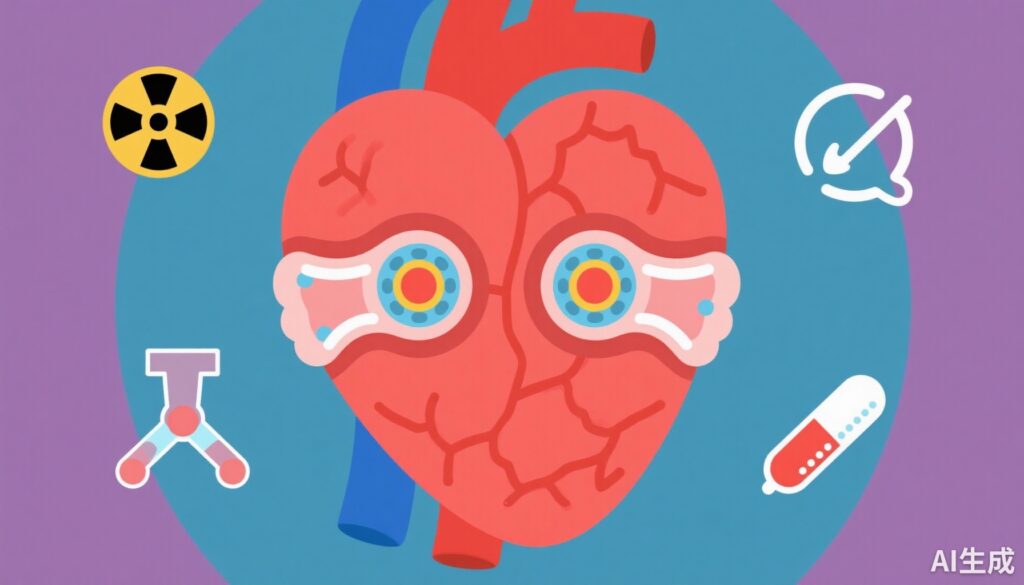Highlight
– Childhood cancer survivors treated with heart radiation therapy (RT), high-dose anthracyclines, or platinum chemotherapy have markedly increased risk of developing symptomatic valvular heart disease (VHD) long-term.
– The risk of VHD escalates exponentially with higher mean heart radiation doses, especially when more than half of the heart is exposed.
– Anthracycline doses exceeding 400 mg/m2 and cumulative platinum exposure also elevate VHD risk, with dose-response relationships.
– Risks from RT and anthracyclines amplify with length of follow-up, underscoring the imperative for lifelong cardiac surveillance in this population.
Study Background
Survival rates for childhood cancer have substantially improved over the past decades, leading to a growing population of long-term survivors. However, these survivors face increased risks of late adverse effects due to cancer therapies, notably cardiotoxicity. Valvular heart disease (VHD), involving pathologic changes to the heart valves leading to stenosis or regurgitation, is one such serious long-term complication. Understanding treatment-related risk factors for VHD is vital to inform screening, prevention, and management strategies in this vulnerable group.
Study Design
This nested case-control study leveraged data from the PanCareSurFup and ProCardio cohorts, encompassing childhood cancer survivors from seven European countries diagnosed between 1940 and 2009 who survived at least five years post-diagnosis. Cases were defined as survivors with symptomatic VHD (Common Terminology Criteria for Adverse Events grade ≥3). Each case was matched with two controls by subcohort, sex, age at diagnosis, and calendar year of diagnosis.
Exposure assessment included precise whole-body dosimetric reconstructions using a voxel-based anthropomorphic phantom with over 200 specific anatomic delineations to calculate mean heart radiation doses, including the portion of the heart irradiated. Cumulative chemotherapy dosing data, notably for anthracyclines and platinum agents, were also evaluated. Data analysis was conducted from October 2023 to June 2025.
Key Findings
The study included 225 valvulopathy cases, predominantly male (60.4%), with most VHD diagnosed beyond 20 years after cancer treatment (86.7%).
1. Radiation Therapy and VHD Risk
Survivors receiving a mean heart RT dose between 5 and less than 15 Gy had a nearly fivefold increased risk of VHD compared to those without heart RT (OR 4.7; 95% CI, 2.1–10.7). The risk rose sharply when more than 50% of the heart was exposed. Notably, the heart dose-response relationship was exponential: mean doses ≥30 Gy were associated with an OR of 104.1 (95% CI, 27.8–389.6). Furthermore, the risk magnified substantially with duration of follow-up, from OR 6.0 (95% CI, 1.4–26.5) at 5–19 years post-treatment to OR 71.4 (95% CI, 20.4–250.0) after 30 or more years.
2. Cumulative Anthracycline Dose
Anthracycline chemotherapy doses ≥400 mg/m2 were significantly associated with increased VHD risk (OR 3.8; 95% CI, 1.4–10.3). The dose-response pattern was exponential, indicating markedly higher risk at higher cumulative doses.
3. Platinum Agents
Cumulative platinum exposure demonstrated a linear association with VHD risk, suggesting even moderate doses contribute to valvulopathy, although the effect size was relatively smaller compared to heart RT or anthracyclines.
4. Other Chemotherapy and Radiation Sites
No statistically significant associations were observed for other chemotherapeutic agents or radiation exposure targeting the spleen, suggesting these factors have minimal impact on VHD risk.
Expert Commentary
This large, rigorous European study leverages detailed radiation dosimetry and comprehensive chemotherapy data to clarify key modifiable risk factors for late valvular heart disease in childhood cancer survivors. The robust exponential dose-response relationships for heart RT and anthracyclines align with biologic plausibility due to progressive degeneration and fibrosis induced in cardiac valve structures by radiation and cumulative anthracycline cardiotoxicity.
Importantly, the magnification of risk with elapsed time from treatment highlights the latent nature of therapy-induced valvulopathy, necessitating lifelong cardiac monitoring. The identification of platinum agents as an additional risk factor expands the known cardiotoxic landscape and warrants further mechanistic and clinical research.
Limitations include potential survivorship bias, given the inclusion of long-term survivors only, and absence of genetic or lifestyle risk factor adjustments. Nonetheless, findings are generalizable across diverse European healthcare settings and historic treatment eras.
Conclusions
In childhood cancer survivors, mean heart radiation therapy dose, high cumulative anthracycline exposure, and platinum chemotherapy independently elevate the long-term risk of symptomatic valvular heart disease. The increasing risk with longer follow-up emphasizes the critical need for structured, lifelong cardiac surveillance protocols integrating detailed treatment history to promptly identify and manage valvular complications. These results underscore the importance of minimizing cardiac exposure during cancer treatment and optimizing chemotherapeutic regimens to mitigate late cardiovascular morbidity in this growing survivor population.
References
Aho Glele R, Feijen EAM, Fresneau B, et al. Risk Factors for Valvulopathy Among Childhood Cancer Survivors. JAMA Oncol. 2025 Oct 9. doi:10.1001/jamaoncol.2025.3863. Epub ahead of print. PMID: 41066131.



